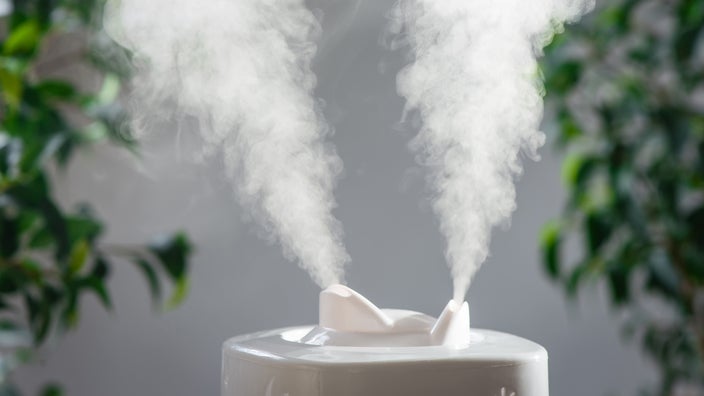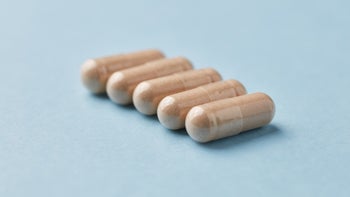
What Does a Humidifier Do, and What Are Their Benefits?
Key takeaways:
Humidifiers add moisture back into the air.
Humidifiers may help with allergy symptoms, snoring, sinus problems, and dry skin.
Humidifiers need regular upkeep. They need to be cleaned every 3 days to prevent possible exposure to mold or other germs.

Winter can be full of holiday cheer, but it can also bring dry skin, chapped lips, and sick days. The air in winter can get dryer in certain regions, and some areas have dry air year-round.
A humidifier may be what you need to keep your symptoms at bay. Humidifiers have gained a reputation as health heroes, doing everything from moistening dry skin to easing congestion.
But do they live up to their hype? We’ll dive into the science behind humidifiers and health, as well as the regular upkeep the devices need.
Search and compare options
What are humidifiers?
If you’ve been in the South during summertime, you’ve likely experienced humidity. It’s that feeling of heavy air, the type that makes you feel hot and sticky. More scientifically speaking, humidity is how much water vapor is in the air. When there’s a lot of water vapor, there’s high humidity. And when there’s little, that’s low humidity.
Humidifiers are devices that increase the level of humidity in your room or home. They’re used to prevent the dryness that can irritate the nose, throat, lips, and skin. So, even if you live in the dry desert, you can restore moisture to the air.
What do humidifiers do?
Humidifiers release water vapor or steam into the air, making the air more humid. Humidifiers work in different ways to release either cool or warm mist into the air. They do this by using a water tank along with some type of technology to break up water into smaller particles that are then released to float in the air.
What are the possible benefits of humidifiers?
The benefits of a humidifier can include helping with:
Allergy symptoms
Snoring
Sinus problems
Dry skin
A humidifier may even help prevent or lower symptoms of the common cold and flu.
Which humidifier is best? Find out the differences between cool mist and warm mist humidifiers.
Does your dry skin flare in winter? Read about different strategies to treat dry skin.
How to treat dry, chapped hands. Here’s what to do if your hands are chapped and peeling.
While some people swear by it, in some cases the research is mixed. Let’s look at the science behind the health benefits of humidifiers.
1. May help allergies
Allergy and asthma symptoms can be extremely bothersome. But humidifiers may help. Humidifiers help by soothing the tissue in your nose and throat. In turn, they can help relieve common symptoms like a dry, itchy throat and runny nose.
However, keeping a perfect humidity balance is key. Too much humidity can cause dust mites and mold to spread, which can also worsen allergies and asthma. (If your home is too humid, you may need a dehumidifier instead.)
Read more like this
Explore these related articles, suggested for readers like you.
Look for humidifiers with the stamp of approval from the Asthma and Allergy Foundation of America.
2. May reduce or stop snoring
If nasal congestion is the cause of your snoring, humidifiers may help by loosening the mucus that blocks your airway.
But, if your snoring is caused by sleep apnea, a humidifier isn’t going to help. It’s best to talk with a healthcare professional if humidifiers and other simple tips aren’t helping you to stop snoring.
3. May relieve dry skin
For many people, dry winter months and dry air-conditioning means dry skin. The American Academy of Dermatology recommends humidifiers to moisten the air and, in turn, your skin. Some research backs this. For example, research on older adults suggests that raising ambient humidity can help ease dry skin.
4. May keep germs at bay
Humidifiers don’t directly kill illness-causing germs. But they may make your room less prone to them.
The germs that make you sick thrive in certain environments and not in others. For example, research suggests that the influenza virus survives and transfers better in cooler, drier conditions. In one preschool setting, classrooms that were kept more humid had fewer influenza virus particles in the air and on objects than classrooms that were kept more dry.
But the research is mixed about other common cold viruses. Humidity might make some viruses more contagious and other viruses less contagious. More research is needed.
5. May ease sinus problems
A humidifier may be helpful when it comes to symptoms like stuffy nose and sinus congestion. When the air is too dry, it can irritate your nasal passageways. An irritated airway can produce more mucus. And if mucus is chronic, it can build up in the sinuses too.
Dry air can also dehydrate mucus, creating mucus that’s thicker and harder to clear when blowing your nose. Humidifiers work by moistening the air, which thins out mucus so it’s easier to clear.
What are the different types of humidifiers?
While all humidifiers will lead to the same result (more moisture in the air), each type works a little differently. This means they have different pros and cons.
Here, we’ll review the main types of humidifiers so you can decide which is best for you.
Central humidifier
Central humidifiers are built into your heating system. The water is heated and then released as water vapor into the home at an adjustable rate.
Having a humidifier built into the heating system is convenient. However, some central humidifiers are prone to developing mold in the ducts. This mold can then be distributed throughout the home, where it might trigger congestion or cough in people who are allergic to it. So it’s important to clean and maintain it once per month to prevent mold.
Steam vaporizer
Steam vaporizers use electricity to create steam that blows into the air. Since the steam is warm, they’re known as “warm-mist” humidifiers. These are less likely to get contaminated with bacteria or mold, since the water is heated. They’re also less expensive and can be used only in the rooms you want to humidify.
But steam vaporizers can get very hot and cause burns around children. So they’re generally not the best choice if you have little ones in your home.
Ultrasonic humidifier
Ultrasonic humidifiers are relatively straightforward devices. They have a water reserve that uses high-speed vibrations to release water droplets into the air. They’re known as “cool-mist” humidifiers because the water is never heated. So they can be a good choice for homes with children because they don’t get too hot.
One drawback to keep in mind: Tap water includes minerals. And since ultrasonic humidifiers release water droplets into the air, they can spread minerals more than some other humidifier types. For this reason, the Environmental Protection Agency (EPA) recommends using demineralized, or distilled, water in this type of humidifier.
Impeller humidifier
Impeller humidifiers are like ultrasonic ones in that they release cool air, so they’re also a good choice for homes with children. However, instead of using vibrations, they use a rotating disk. The EPA also recommends using demineralized or distilled water for impeller humidifiers.
Evaporator
Evaporator humidifiers are a commonly used type of humidifier. They use a container of water and a fan to blow air through a wet filter. This disperses a cool mist into the air. The filter traps minerals, so there’s less risk of blowing mineral dust throughout the room. Any kind of water is generally acceptable.
How often should you use a humidifier?
Because humidifiers moisten the air, they’re best for when the air is dry. In general, humidity tends to be lower in the winter. And as the humidity drops with the winter season, so does the humidity in your home.
But using air-conditioning in the summer can also lower the humidity inside. This might sound confusing. The key is to use a humidifier if your home has low humidity.
But how will you know? Consider investing in a hygrometer, a device that reads the humidity levels in your home. If it reads below 40%, consider a humidifier.
How to use and maintain your humidifier
Even the best humidifiers need regular maintenance — more than you’d expect from such a small comforting device. Humidifiers work best if you follow the cleaning instructions. Here are some handy tips on how to take care of the pesky device.
Clean every third day
Without proper cleaning, your humidifier can become a breeding ground for bacteria and mold — both of which can make you sick. The EPA recommends cleaning the device every 3 days.
Here are step-by-step directions:
Empty your water tank. Let it dry completely for 30 to 60 minutes.
While you wait, take apart your device and give each part a surface scrub.
Use a brush or scrubber to clean the tank. You can add an acid, like apple cider vinegar, to help remove limestone buildup.
Disinfect every month or so
A good cleaning is necessary. But it may not remove all bacteria and other microorganisms that can build up. To disinfect your device, clean all surfaces that touch water with a 3% solution of hydrogen peroxide. Make sure to rinse thoroughly so the disinfectant doesn’t spread throughout the air.
Use distilled bottled water
The federal government hasn’t concluded that the minerals in tap water pose a serious health risk. But it can make white dust build up in the humidifier, according to the EPA. It’s possible that the white dust could be harmful to the lungs if inhaled. So the EPA cautions that it’s best to use distilled water in ultrasonic and impeller humidifiers.
Some experts say it’s best to choose distilled water in general regardless of what type of humidifier you’re using. Distilled bottled water has a low mineral content, meaning few minerals will be dispersed into the air. A low mineral content also means less grime to clean.
Don’t exceed 50% humidity levels
Higher humidity levels mean more chances of dangerous organisms. Hygrometers are a handy tool for measuring humidity levels. Plus, if you notice condensation on windows and damp surroundings, lower the humidity.
Remember to replace the filter
If your humidifier uses a filter system, be sure to replace it every 6 months or as the manufacturer recommends.
Keep the humidifier away from the bed
Be sure to place your humidifier several feet (about 2 m) away from the bed. But keep in mind that every humidifier is different. Refer to your humidifier’s user manual if you have any questions.
Frequently asked questions
You may not need to use a humidifier all day and night. It may cause humidity levels to get too high (above 50%), and that can lead to a buildup of mold and mildew.
But as long as you’re keeping an eye on the humidity levels, a humidifier may help some symptoms that can affect your sleep. For example, it may help moisten the tissue in your nose and throat, which can help prevent a dry throat and runny nose. And it may reduce snoring if your snoring is related to nasal congestion.
If you live in a dry climate, increasing the humidity in your home with a humidifier can help keep your nasal passages moist, and it may make mucus thinner. These may both help with a cough, though research is limited.
The main potential risk of using a humidifier is that it can lead to microorganisms in the air. Young children, older adults, and people with lung conditions or respiratory allergies may be susceptible to these microorganisms.
You can help prevent this from happening by using a humidifier correctly and cleaning it regularly.
Certain types of humidifiers, like impeller and ultrasonic humidifiers, may put minerals and microorganisms in the air. The health effects of these aren’t known. If you follow the instructions, though, most people should be able to use humidifiers safely.
Why trust our experts?



References
Aganovic, A., et al. (2022). Modeling the impact of indoor relative humidity on the infection risk of five respiratory airborne viruses. Scientific Reports.
American Academy of Allergy Asthma and Immunology. (2023). Humidifiers and indoor allergies.
Arundel, A. V., et al. (1986). Indirect health effects of relative humidity in indoor environments. Environmental Health Perspectives.
Asthma and Allergy Friendly. (n.d.). Dehumidifiers.
Asthma and Allergy Friendly. (n.d.). Humidifiers.
Consumer Product Safety Commission. (n.d.). Dirty humidifiers may cause health problems.
Duan, J., et al. (2019). Risk effects of high and low relative humidity on allergic rhinitis: Time series study. Environmental Research.
Environmental Protection Agency. (1991). Use and care of home humidifiers.
Gerber, P., et al. (1981). Humidifier lung. Swiss Medical Weekly.
Goad, N., et al. (2016). Ambient humidity and the skin: The impact of air humidity in healthy and diseased states. Journal of the European Academy of Dermatology and Venereology.
Gromicko, N., et al. (n.d.). Central humidifiers. International Association of Certified Home Inspectors.
Kaneshiro, N. K., et al. (2022). Humidifiers and health. MedlinePlus.
Lowen, A. C., et al. (2007). Influenza virus transmission is dependent on relative humidity and temperature. Public Library of Science Pathogens.
Ludmann, P. (2024). Dermatologists’ top tips for relieving dry skin. American Academy of Dermatology Association.
ManualsLib. (n.d.). About ManualsLib.
Reiman, J. M., et al. (2018). Humidity as a non-pharmaceutical intervention for influenza A. Public Library of Science One.
White-Chu, E. F., et al. (2011). Dry skin in the elderly: Complexities of a common problem. Clinics in Dermatology.





























